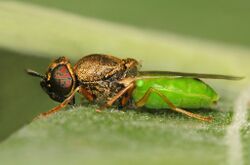Biology:Oplodontha viridula
| Oplodontha viridula | |
|---|---|

| |
| Scientific classification | |
| Domain: | Eukaryota |
| Kingdom: | Animalia |
| Phylum: | Arthropoda |
| Class: | Insecta |
| Order: | Diptera |
| Family: | Stratiomyidae |
| Subfamily: | Stratiomyinae |
| Tribe: | Stratiomyini |
| Genus: | Oplodontha |
| Species: | O. viridula
|
| Binomial name | |
| Oplodontha viridula (Fabricius, 1775)[1]
| |
| Synonyms | |
| |
Oplodontha viridula, the common green colonel, is a European species of soldier fly. [15][16][17]
Description
Body length 6–8 mm. Purple eyes in life with bands and spots. Thorax brilliant black, coarsely punctured and with short dull yellow pubescence. Scutellum entirely black with two yellow spines. Yellowish legs (female). Abdomen whitish, yellow or leaf green with all intermediate ranges; black longitudinal dorsal median band also variable in shape and extent than the background pastel color. The larva is light or dark brownish with different longitudinal stripes or markings: on the dorsal side it has short, depressed hairs, on the ventral side the middle space of the segments have somewhat longish hairs. The length is 16 mm.[18][19][20][21]
Biology
The habitat is wetland biotope, such as marshes, meadows with locks, salt marshes and river valleys- in humid places, on herbs, Phragmites, Cnicus Adults are found from the end of April to the beginning of October. Adults feed on pollen and nectar of Achillea millefolium ........
Distribution
Throughout the Palearctic.
References
- ↑ 1.0 1.1 Fabricius, J.C. (1775). Systema entomologiae, sistens insectorum classes, ordines, genera, species, adiectis synonymis, locis, descriptionibus, observationibus.. Flensbvrgi et Lipsiae [= Flensburg & Leipzig]: Kortii. pp. [32] + 832. https://www.biodiversitylibrary.org/item/82400#page/5/mode/1up. Retrieved 20 February 2021.
- ↑ 2.0 2.1 Meigen, J. W. (1822). Systematische Beschreibung der bekannten europaischen zweiflugeligen Insekten. Hamm: Dritter Theil. Schulz-Wundermann. pp. x, 416, pls. 22–32. https://www.biodiversitylibrary.org/item/49298#page/7/mode/1up. Retrieved 14 April 2019.
- ↑ Villers, C.J. de (1789). Caroli Linnaei entomologia Vol. 3. Lugduni [=Lyon].: Piestre & Delamolliere. pp. 657 pp., 4 pls.
- ↑ Panzer, G.W.F. (1798). Favnae insectorvm germanicae initia oder Devtschlands Insecten. Heft 55-60. Nurnberg: Felsecker. pp. H. 58, 24 pp., 24 pls. https://www.biodiversitylibrary.org/item/53116#page/5/mode/1up. Retrieved 19 March 2023.
- ↑ Schrank, F. von Paula (1803). Favna Boica. Durchgedachte Geschichte der in Baiern einheimischen und zahmen Thiere. Vol. 3. Landshut: Krull. pp. Pt. 1. viii + 372 pp.
- ↑ Meigen, J.W. (1804). Klassifikazion und Beschreibung der europäische n zweiflugeligen Insekten (Diptera Linn.). Erster Band. Abt. I.. Braunschweig [= Brunswick]: Reichard. pp. xxviii + pp. 1–152, Abt. II. vi + pp. 153–314.
- ↑ Olivier, G.A. (1811). Insectes [(i.e., Arthropoda) Pt. 5]. Vol. 8, (=livr. 75) [1811.04.30]; pp. 361-722 (=livr. 77), [1811.10.23]. In Encyclopedie methodique. Histoire naturelle. .. Paris. pp. 1–360.
- ↑ Macquart, P.J.M. (1826). "Insectes diptères du nord de la France. Asiliques, bombyliers, xylotomes, leptides, stratiomyides, xylophagites et tabaniens". Mem. Soc. Sci. Agric. Arts, Lille 1825: 324-499, 3 pls.
- ↑ Schrank, F. von Paula (1837). "Names and nomina nuda in Gistl, 1837". Faunus, Zeitschr. Zool. Vergl. Anat. (2) 1 (1): 5–19.
- ↑ 10.0 10.1 Loew, H. (1846). "Fragmente zur Kenntniss der europäische n Arten einiger Dipterengattungen". Linn. Ent. 1: 319–530, pl. III.
- ↑ Schiner, I.R. (1855). "Diptera Austriaca II. Die osterreichischen Stratiomyden und Xylophagiden". Verhandlungen der Zoologisch-Botanischen Gesellschaft in Wien 5: 613–682.
- ↑ Jaennicke, J.F. (1866). "Beiträge zur Kenntniss der europäische n Stratiomyden, Xylophagiden u. Coenomyiden sowie Nachtrag zu den Tabaniden". Berliner entomologische Zeitschrift 10 (1–3): 217–237. doi:10.1002/mmnd.18660100114. https://www.biodiversitylibrary.org/page/8340365#page/237/mode/1up. Retrieved 14 March 2023.
- ↑ Brunetti, E. (1889). "List of the British Stratiomyidae, with analytical tables and notes [part"]. The Entomologist 22 (312): 130–134. https://www.biodiversitylibrary.org/page/11410684#page/156/mode/1up. Retrieved 21 March 2023.
- ↑ Verrall, G. H. (1909). Stratiomyidae and succeeding families of the Diptera Brachycera of Great Britain British flies. 5. London: Gurney and Jackson. pp. 780, 34 p., 407 fig. https://www.biodiversitylibrary.org/item/36929#page/7/mode/1up. Retrieved 19 October 2022.
- ↑ Stubbs, Alan E; Drake, Martin (2014). British Soldierflies and their allies (an illustrated guide to their identification and ecology) (2 ed.). Reading: British Entomological and Natural History Society. pp. 528 pp, 20 plates. ISBN 9781899935079.
- ↑ Woodley, N.E. (2001). "A World Catalog of the Stratiomyidae (Diptera)". Myia 11: 1–462. https://www.researchgate.net/publication/303225468. Retrieved 7 December 2022.
- ↑ Zeegers, T.; Schulten, A. (2022). Families of Flies with Three Pulvilli: Field Guide Northwest Europe. Graveland: Jeugdbondsuitgeverij. pp. 256pp. ISBN 9789051070682.
- ↑ Seguy. E. Faune de France Faune n° 13 1926. Diptères Brachycères.308 p., 685 fig.
- ↑ George Henry VerrallStratiomyidae and succeeding families of the Diptera Brachycera of Great Britain- British flies (1909)BHL Full text with illustrations
- ↑ E. P. Narchuk in Bei-Bienko, G. Ya, 1988 Keys to the insects of the European Part of the USSR Volume 5 (Diptera) Part 2 English edition. Keys to Palaearctic species but now needs revision.
- ↑ William Lundbeck Diptera Danica. Genera and species of flies Hitherto found in Denmark. Copenhagen & London, 1902-1927. 7 vols
 This article incorporates text from this source, which is in the public domain.
This article incorporates text from this source, which is in the public domain.
Wikidata ☰ Q646210 entry
 |




